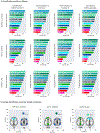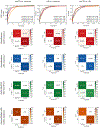Dynamic brain fluctuations outperform connectivity measures and mirror pathophysiological profiles across dementia subtypes: A multicenter study
- PMID: 33144220
- PMCID: PMC7832160
- DOI: 10.1016/j.neuroimage.2020.117522
Dynamic brain fluctuations outperform connectivity measures and mirror pathophysiological profiles across dementia subtypes: A multicenter study
Abstract
From molecular mechanisms to global brain networks, atypical fluctuations are the hallmark of neurodegeneration. Yet, traditional fMRI research on resting-state networks (RSNs) has favored static and average connectivity methods, which by overlooking the fluctuation dynamics triggered by neurodegeneration, have yielded inconsistent results. The present multicenter study introduces a data-driven machine learning pipeline based on dynamic connectivity fluctuation analysis (DCFA) on RS-fMRI data from 300 participants belonging to three groups: behavioral variant frontotemporal dementia (bvFTD) patients, Alzheimer's disease (AD) patients, and healthy controls. We considered non-linear oscillatory patterns across combined and individual resting-state networks (RSNs), namely: the salience network (SN), mostly affected in bvFTD; the default mode network (DMN), mostly affected in AD; the executive network (EN), partially compromised in both conditions; the motor network (MN); and the visual network (VN). These RSNs were entered as features for dementia classification using a recent robust machine learning approach (a Bayesian hyperparameter tuned Gradient Boosting Machines (GBM) algorithm), across four independent datasets with different MR scanners and recording parameters. The machine learning classification accuracy analysis revealed a systematic and unique tailored architecture of RSN disruption. The classification accuracy ranking showed that the most affected networks for bvFTD were the SN + EN network pair (mean accuracy = 86.43%, AUC = 0.91, sensitivity = 86.45%, specificity = 87.54%); for AD, the DMN + EN network pair (mean accuracy = 86.63%, AUC = 0.89, sensitivity = 88.37%, specificity = 84.62%); and for the bvFTD vs. AD classification, the DMN + SN network pair (mean accuracy = 82.67%, AUC = 0.86, sensitivity = 81.27%, specificity = 83.01%). Moreover, the DFCA classification systematically outperformed canonical connectivity approaches (including both static and linear dynamic connectivity). Our findings suggest that non-linear dynamical fluctuations surpass two traditional seed-based functional connectivity approaches and provide a pathophysiological characterization of global brain networks in neurodegenerative conditions (AD and bvFTD) across multicenter data.
Keywords: AD; Copula-based dependence measure; Dynamic functional connectivity; bvFTD; fMRI resting-state connectivity.
Copyright © 2020 The Author(s). Published by Elsevier Inc. All rights reserved.
Conflict of interest statement
Declaration of Competing Interest The authors report no competing interests.
Figures




References
-
- Agosta F, P. M, Geroldi C, Copetti M, Frisoni GB, Filippi M, 2012. Resting state fMRI in Alzheimer’s disease: beyond the default mode network. Neurobiol Aging. 33 (8), 1564–1578. - PubMed
-
- Agosta F, et al., 2013. Brain network connectivity assessed using graph theory in frontotemporal dementia. Neurology 81 (2), 134–143. - PubMed
-
- Alladi S, Hachinski V, 2018. World dementia: one approach does not fit all. Neurology 91 (6), 264–270. - PubMed
Publication types
MeSH terms
Grants and funding
LinkOut - more resources
Full Text Sources
Other Literature Sources
Medical
Research Materials

